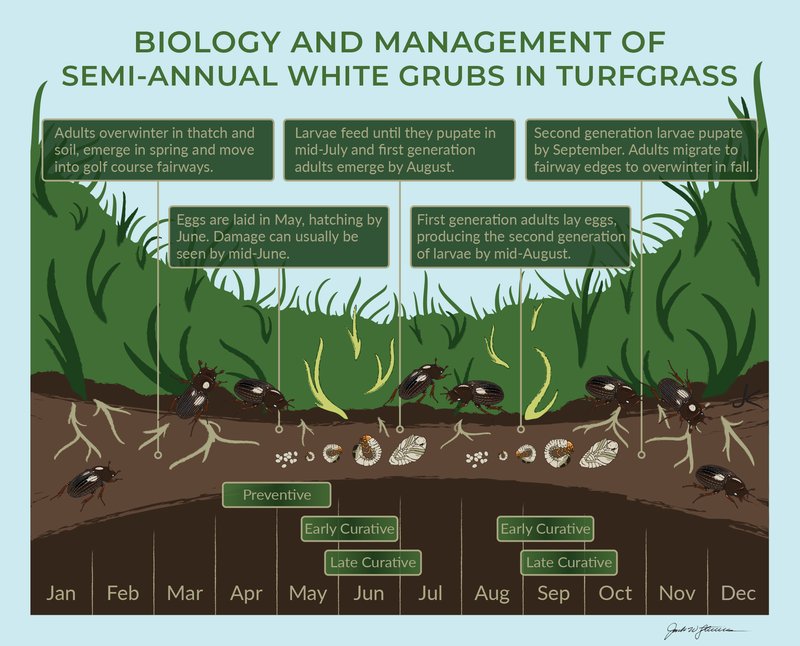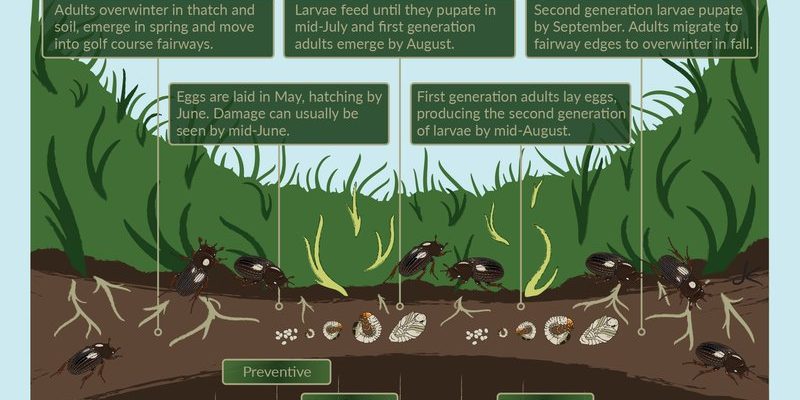
Grub worms are the larval stage of beetles, most commonly the **Japanese beetle**, but others can be just as problematic. These little guys can cause significant damage if they’re left unchecked. They feast on the roots of your grass, ultimately leading to weak, patchy, and even dead areas in your lawn. When your turfgrass can’t draw nutrients and water effectively from the soil, it’s like trying to run a marathon on an empty stomach—it just won’t work! So, let’s dig deeper and see how these critters impact your lawn and what you can do about it.
Understanding Grub Worms and Their Habits
Grub worms thrive in warm, moist environments, making them quite common in many regions during late summer and early fall. They primarily feed on the roots of grass, which can be a significant threat to the health of your turf. These larvae spend a substantial amount of their life cycle underground, munching away when you’re not even aware of their presence.
You might be wondering how to recognize if these pesky critters are in your lawn. Common signs include **brown patches**, grass that pulls up easily, or areas that feel spongy beneath your feet. It’s like the lawn is saying, “Please help me!” A closer look during the late summer can reveal their existence. Just dig a small hole and see if you find any larvae lurking.
Understanding their life cycle is essential for tackling grub issues effectively. They start as eggs, hatch into larvae, and then mature into adult beetles. This cycle continues, and if your lawn had grubs last season, there’s a good chance they’ll show up again!
Effects of Grub Worms on Turfgrass Roots
Grub worms have a direct, detrimental effect on turfgrass root systems. As they feast on the roots, they essentially **strip away the foundation** that your grass needs to thrive. Without strong roots, grass can’t absorb water and nutrients, leading to a host of problems.
When the roots are compromised, the grass becomes stressed. This stress manifests as changing colors, wilting, or even large sections dying off. You might start to notice your once-vibrant lawn turning yellow or brown. It’s like watching a strong athlete collapse during a race—without the energy and support they need, they can’t continue to perform.
Moreover, the presence of grub worms can weaken the overall structure of the soil as well. As they chew through roots, they create spaces that can lead to reduced soil stability. This can make your lawn more susceptible to other pests and diseases, making an already tough situation even worse.
Identifying Grub Damage in Your Lawn
To nip the problem in the bud, you need to know what to look for when it comes to grub damage. As I mentioned, looking for **brown patches** is key, but there are other signs that might indicate an issue.
1. **Grass Pull Test**: If you tug on a patch of grass and it comes up easily, that’s a red flag. Healthy grass should have a firm hold thanks to its roots.
2. **Soil Inspection**: Dig down a few inches with a spade. Look for grubs in the soil. If you find them, especially in numbers, it’s an indication that your lawn is in trouble.
3. **Bird Activity**: Increased bird activity can be a sign of grub worms. Birds love to feast on these larvae, so if you see them pecking around, be alert.
Knowing these signs can help you act quickly. Catching the problem early means you can take steps to protect your turfgrass before it’s too late.
Best Practices for Managing Grub Worm Populations
When it comes to managing grub worms, there are a few strategies you can employ. Just like any good game plan, you want to combine different methods for the best results.
1. **Preventive Treatments**: Applying grub control products in early summer can deter eggs from hatching. Look for products containing **imidacloprid** or **chlorantraniliprole**. These are commonly found in insecticides designed for grub control and can help knock them out before they get a foothold.
2. **Healthy Lawn Practices**: Keeping your lawn healthy is crucial. Regular mowing, watering, and aerating will strengthen your turfgrass, making it more resistant to grub damage. A healthy lawn can often bounce back from minor infestations.
3. **Natural Predators**: Encourage natural predators like birds and beneficial nematodes in your garden. Birds can help keep grub populations in check, while nematodes specifically target larvae when introduced to the soil.
Balancing these practices will give you the best chance at maintaining a lush, green lawn, saving you time, money, and frustration down the road.
When to Call a Professional
Sometimes, despite your best efforts, grub worms can still wreak havoc on your lawn. If you notice widespread damage and can’t seem to tackle the issue on your own, it might be time to call in the professionals.
A turf management specialist can provide a thorough assessment and recommend tailored treatments for your specific situation. They have access to more potent products and tools that homeowners might not. If you find that DIY treatments aren’t cutting it, don’t hesitate to reach out for help.
Finding a reliable lawn care service can make all the difference in restoring the health of your turfgrass. Just like any good coach, they can guide you through tough times and help your lawn come back stronger.
Long-Term Lawn Health Strategies
Once you’ve tackled the current grub worm problem, it’s essential to think long-term. Developing a strategic lawn care plan can help prevent future infestations and maintain a strong root system.
– **Seasonal Care**: Schedule regular lawn care based on the seasons. Early and late fall is usually prime for fertilization and aeration.
– **Soil Testing**: Conduct soil tests to determine nutrient levels. This can guide you in amending the soil properly, ensuring your grass has what it needs.
– **Diversity in Planting**: Consider mixing your grass types to create a more resilient lawn. Some species are more tolerant to pests than others, providing natural defenses.
Thinking ahead can save you headaches later on and keep your turfgrass flourishing through any challenges.
As you can see, grub worms can significantly impact the health of your lawn by targeting its root systems. By understanding how they operate, identifying their presence, and employing effective management strategies, you can protect your turfgrass and enjoy the lush, beautiful lawn you desire. Remember, a little knowledge goes a long way—just like nurturing a garden, caring for your lawn is an ongoing journey worth taking.

